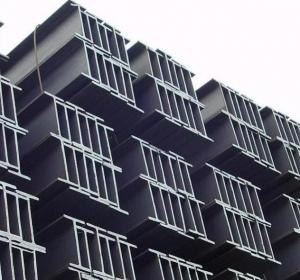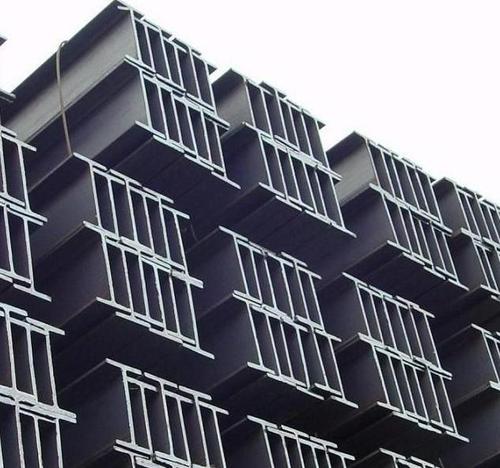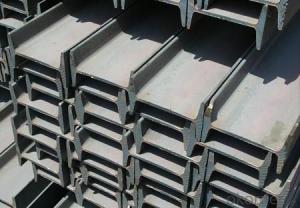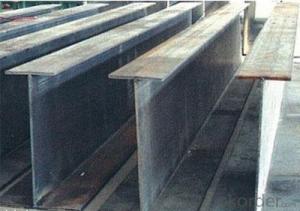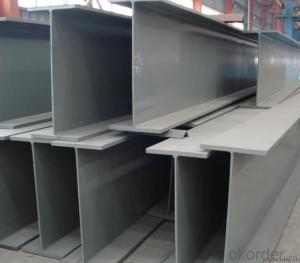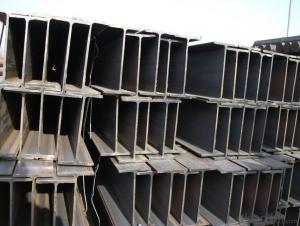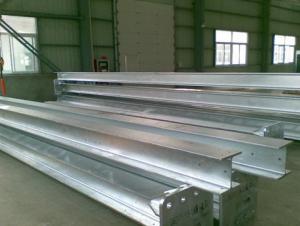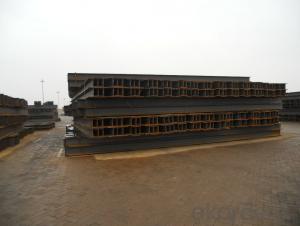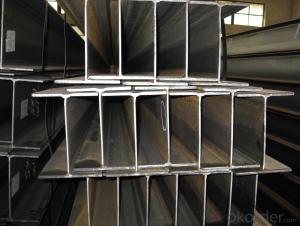ASTM A36 Steel H Beams Used for Construction
- Loading Port:
- China Main Port
- Payment Terms:
- TT or LC
- Min Order Qty:
- 100 m.t.
- Supply Capability:
- 10000 m.t./month
OKorder Service Pledge
OKorder Financial Service
You Might Also Like
Product Description:
OKorder is offering ASTM A36 Steel H Beams Used for Construction at great prices with worldwide shipping. Our supplier is a world-class manufacturer of steel, with our products utilized the world over. OKorder annually supplies products to African, South American and Asian markets. We provide quotations within 24 hours of receiving an inquiry and guarantee competitive prices.
Product Applications:
ASTM A36 Steel H Beams Used for Construction are ideal for structural applications and are widely used inindustrial plants, civil construction, municipal works, oil platforms, bridges, flatbed beams, electrified railway power stand, railway bridges and other light steel structure, super-light H-beam is ideal for containers, mobile homes , all kinds of garage, box-type trains, electrical bracket, various venues, small villa manufacturing etc.
Product Advantages:
OKorder's ASTM A36 Steel H Beams Used for Construction are durable, strong, and wide variety of sizes.
Main Product Features:
· Premium quality
· Prompt delivery & seaworthy packing (30 days after receiving deposit)
· Can be recycled and reused
· Mill test certification
· Professional Service
· Competitive pricing
Product Specifications:
Manufacture: Hot rolled
Grade: Q195 – 235
Certificates: ISO, SGS, BV, CIQ
Length: 12m, as per customer request
Packaging: Export packing, nude packing, bundled
size | Kg/m |
100*100 | 16.9 |
125*125 | 23.6 |
150*75 | 14 |
150*150 | 31.1 |
148*100 | 20.7 |
198*99 | 17.8 |
200*100 | 20.9 |
248*124 | 25.1 |
250*125 | 29 |
Trademark | Rank | Chemical composition (quality score) % | |||||
C | Si | Mn | S | P | |||
≤ | ≤ | ≤ | |||||
Q235 | A | 0.14-0.22 | 0.30 | 0.30-0.65 | 0.050 | 0.045 | |
Q235 | B | 0.12-0.20 | 0.30 | 0.30-0.70 | 0.045 | 0.045 | |
Trademark | Rank | Pulling Test | |||||
Bend PointΔs/Mpa | Tensile Strength | Elongation Ratioδ5% | |||||
Thickness (Diameter) /MM | Thickness (Diameter) /MM | ||||||
≤16 | 16-40 | ≤16 | 16-40 | ||||
≥ | ≥ | ||||||
Q235 | A | 235 | 225 | 375-500 | 26 | 25 | |
Q235 | B | 235 | 225 | 375-500 | 26 | 25 | |
FAQ:
Q1: How many tons of steel products could be loaded in containers?
A1: Usually the steel products are delivered by bulk vessel because of the large quantity and the freight. However, there are no bulk vessel enter some seaports so that we have to deliver the cargo by containers. The 6m steel product can be loaded in 20FT container, but the quantity is changed according to the size, usually from 18tons to 25tons.
Q2: How do we guarantee the quality of our products?
A2: We have established an advanced quality management system which conducts strict quality tests at every step, from raw materials to the final product. At the same time, we provide extensive follow-up service assurances as required.
Q3: How soon can we receive the product after purchase?
A3: Within three days of placing an order, we will arrange production. The normal sizes with the normal grade can be produced within one month. The specific shipping date is dependent upon international and government factors, the delivery to international main port about 45-60days.
Images:
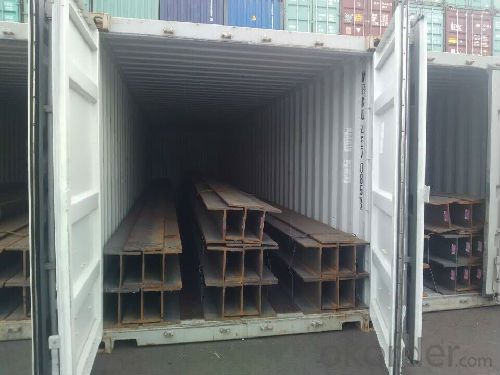
- Q: H steel compared with ordinary steel in the end what are the advantages and disadvantages?
- Increase the effective use area of the structure: compared with the concrete structure, the steel structure column has a small cross sectional area, thus increasing the effective use area of the building, and depending on the different forms of the building, it can increase the effective use area of 4-6%.
- Q: Can steel H-beams be used in high-rise buildings?
- Indeed, high-rise buildings can make use of steel H-beams. These beams are frequently employed as structural components within the construction sector owing to their exceptional strength and adaptability. They possess the ability to endure substantial loads and are frequently utilized to bear the weight of floors, walls, and roofs in tall buildings. The distinctive H shape of these beams offers a larger surface area for distributing the load, rendering them an optimal selection for structures of great height that experience significant weight and pressure on the beams. Furthermore, steel H-beams can be effortlessly fabricated, affording efficient construction procedures in high-rise buildings.
- Q: What are the design considerations for steel H-beams in coastal areas?
- Some key design considerations for steel H-beams in coastal areas include corrosion resistance, durability against saltwater exposure, and high wind loads. The beams should be made from corrosion-resistant materials, such as stainless steel or galvanized steel, to prevent the deterioration caused by saltwater. Additionally, the design should account for the increased risk of corrosion due to the high salt content in the atmosphere. The beams should also be able to withstand the strong winds and potential storm surges commonly experienced in coastal regions. Proper anchoring and bracing techniques should be employed to ensure the structural integrity and stability of the beams in these challenging environmental conditions.
- Q: Can steel H-beams be used in underground construction projects?
- Yes, steel H-beams can be used in underground construction projects. Steel H-beams are commonly used in various construction projects due to their strength, durability, and versatility. In underground construction, these beams can be used to create structural support systems or frameworks for tunnels, underground parking lots, subways, or basements. They are capable of withstanding heavy loads and provide excellent resistance against various forces, such as compression and tension, making them suitable for underground environments. Additionally, steel H-beams can be easily assembled and disassembled, allowing for flexibility and adaptability in underground construction projects. Overall, steel H-beams are a reliable and efficient choice for underground construction projects.
- Q: The difference and use of H type steel steel and steel.
- H steel is a kind of economical section steel with better mechanical performance, especially the cross section, which is named after the English letter "H". Its features are as follows:The flange width, lateral stiffness.The bending capacity, than the beam about 5%-10%.The two flange surfaces parallel to each other makes the connection, convenient manufacture and installation.
- Q: What are the different methods of reinforcing steel H-beams?
- There are several methods of reinforcing steel H-beams, which are commonly used in construction to provide structural support. These methods aim to enhance the strength, durability, and load-bearing capacity of H-beams, ensuring their optimal performance in various applications. 1. Welding: One of the most common methods of reinforcing steel H-beams is through welding. Welding is used to join two or more H-beams together, creating a stronger and more rigid structure. It is typically done by melting the edges of the beams and fusing them together using heat and pressure. Welding can also be used to attach additional steel plates or angles to the H-beam, further strengthening its overall structure. 2. Shear Connectors: Shear connectors are another method of reinforcing H-beams, primarily used in composite construction. These connectors are typically steel studs or bars that are welded onto the top flange of the H-beam. The purpose of shear connectors is to transfer the shear forces between the concrete slab and the steel beam, improving the structural integrity and load-carrying capacity of the H-beam. 3. Steel Plates: The use of steel plates is a common method to reinforce H-beams, especially when dealing with heavy loads or long spans. Steel plates are typically bolted or welded to the web or flanges of the H-beam, providing additional strength and stiffness. The size and thickness of the steel plates can be customized based on the specific requirements of the project. 4. Composite Beams: Composite beams are created by combining a steel H-beam with a concrete slab. This method involves placing the concrete slab on top of the H-beam and connecting them together with shear connectors, such as steel studs or bars. Composite beams offer several advantages, including increased load-carrying capacity, better fire resistance, and improved overall stiffness. 5. Reinforced Concrete Encasement: Another method of reinforcing H-beams is through reinforced concrete encasement. This technique involves wrapping the H-beam with reinforced concrete, usually achieved by constructing formwork around the beam and pouring concrete into the formwork. The concrete encasement enhances the strength and stiffness of the H-beam, providing additional resistance against bending, shear, and other forces. It is important to note that the choice of reinforcing method depends on the specific requirements of the project, such as the load requirements, span length, construction constraints, and design considerations. Consulting with a structural engineer or a construction professional is highly recommended to determine the most suitable method for reinforcing steel H-beams in a given application.
- Q: What does "welding H" steel set "vertical" and "corrective processing" mean?
- The steel plant produces H steel with a special machine to process a 500*300*12*10 H steel of a length of 12 meters
- Q: 248 H steel GB thickness?
- GB H type steel: narrow flange HN250 * 125 models, 248 x 124 x 5 x 8 - 3289mm, cross-sectional area, weight 25.8kg/m.
- Q: Can steel H-beams be used for residential construction?
- Certainly, residential construction can indeed utilize steel H-beams. These structural elements, renowned for their robustness and endurance, are frequently employed in construction. Crafted from steel, H-beams are engineered to bear substantial loads and provide essential support to the edifice. In residential construction, these steel H-beams are commonly harnessed for a range of purposes, such as bolstering roof structures, creating expansive floor plans, or constructing expansive areas. Their versatility allows for a myriad of applications, tailored to the specific design and requisites of the residential venture. Furthermore, steel H-beams confer numerous advantages, including a remarkable strength-to-weight ratio, resistance to fire, and long-lasting durability, rendering them an appropriate choice for residential construction.
- Q: Can steel H-beams be used in the construction of industrial buildings?
- Indeed, industrial buildings can incorporate steel H-beams into their construction plans. The utilization of steel H-beams as support elements is widespread in industrial buildings because of their remarkable strength, durability, and versatility. These beams are specifically engineered to endure immense loads and provide steadfastness to the structure. Moreover, their elongated span capabilities render them ideal for the expansive spaces commonly found in industrial buildings. Additionally, the fabrication and installation processes of steel H-beams are straightforward, resulting in reduced construction time and expenses. Furthermore, their resistance to fire and ability to withstand harsh weather conditions establish them as a dependable option for industrial buildings. In conclusion, the robustness, endurance, and adaptability of steel H-beams make them a favored selection for industrial construction projects.
Send your message to us
ASTM A36 Steel H Beams Used for Construction
- Loading Port:
- China Main Port
- Payment Terms:
- TT or LC
- Min Order Qty:
- 100 m.t.
- Supply Capability:
- 10000 m.t./month
OKorder Service Pledge
OKorder Financial Service
Similar products
Hot products
Hot Searches
Related keywords
